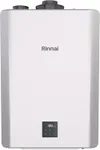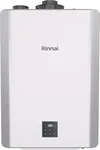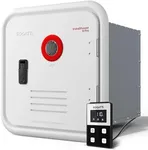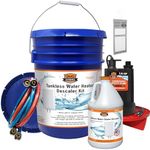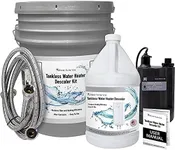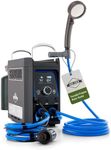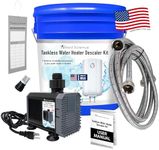Buying Guide for the Best Tankless Gas Water Heaters
Choosing the right tankless gas water heater can significantly improve your home's energy efficiency and ensure you have a reliable supply of hot water. Tankless water heaters heat water on demand, which means they don't store hot water like traditional tank heaters. This can save you money on energy bills and provide an endless supply of hot water. However, selecting the right model involves understanding several key specifications to ensure it meets your household's needs.Flow Rate (GPM)Flow rate, measured in gallons per minute (GPM), indicates how much hot water the unit can produce at a given time. This is crucial because it determines whether the heater can meet your household's hot water demands. For example, a flow rate of 3-4 GPM is suitable for small households with one or two fixtures running simultaneously, while larger households with multiple fixtures may require a flow rate of 7-10 GPM. To choose the right flow rate, consider the number of people in your home and the number of hot water fixtures you expect to use at the same time.
Energy Efficiency (EF Rating)The Energy Factor (EF) rating measures the efficiency of the water heater in converting fuel into hot water. A higher EF rating means the unit is more efficient, which can lead to lower energy bills. EF ratings typically range from 0.8 to 0.99. For those looking to maximize energy savings, a higher EF rating is preferable. However, even a mid-range EF rating can offer significant improvements over traditional tank water heaters. Consider your energy consumption habits and prioritize higher EF ratings if reducing energy costs is a primary concern.
BTU RatingBTU (British Thermal Unit) rating measures the heating capacity of the water heater. Higher BTU ratings mean the unit can heat water more quickly and handle higher flow rates. BTU ratings for tankless gas water heaters typically range from 120,000 to 199,000 BTUs. If you have a large household or high hot water demand, a higher BTU rating will ensure you have enough hot water. For smaller households or lower hot water usage, a lower BTU rating may be sufficient and more cost-effective.
Venting RequirementsTankless gas water heaters require proper venting to expel combustion gases safely. There are two main types of venting: direct vent and power vent. Direct vent systems draw air from outside and are ideal for homes with limited indoor ventilation, while power vent systems use indoor air and require an exhaust fan. The choice between these depends on your home's layout and existing ventilation infrastructure. Ensure you understand your home's venting capabilities and choose a model that aligns with them to ensure safe and efficient operation.
Size and Installation SpaceTankless gas water heaters are generally more compact than traditional tank heaters, but they still require adequate space for installation and maintenance. Consider the dimensions of the unit and the available space in your home. Ensure there is enough clearance around the unit for proper ventilation and access for maintenance. If space is limited, look for more compact models designed for tight installations. Proper sizing and placement are crucial for both performance and safety.
Temperature RiseTemperature rise refers to the difference between the incoming cold water temperature and the desired hot water temperature. This is important because it affects the heater's ability to provide consistent hot water. For example, if your incoming water temperature is 50°F and you want it heated to 120°F, the required temperature rise is 70°F. Different models have varying capabilities for temperature rise, so choose one that can handle the temperature rise needed for your region and usage patterns. Consider the climate you live in and the typical temperature of your incoming water when making your selection.
